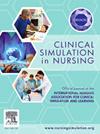产科多学科小组高脊柱模拟
IF 2.5
3区 医学
Q1 NURSING
引用次数: 0
摘要
背景:高脊髓是产科麻醉中一种罕见但可能危及生命的并发症,其定义为T4以上脊髓神经阻滞。提供者常常感到无力应对他们很少或从未经历过的紧急情况。基于多学科OB模拟的培训(SBT)已被证明可以在紧急情况下提高知识、信心和团队绩效。方法将美国东南部一家医院的23名产科多学科团队参与者纳入介入前后设计。参与者完成了评估知识和信心的调查,参加了基线模拟,并参加了一个以脊柱识别和管理为重点的教育会议。然后,参与者重复模拟并完成任务汇报和教育后调查。结果教育前后学生知识评估得分由84.8%上升至88.6% (p = .446);对脊柱高位管理的信心显著提高(p = 0.002),完成团队任务的百分比从59.9%提高到81.0% (p = 0.001)。结论:本项目证明了SBT可以潜在地提高高脊柱多学科团队管理的知识、信心和任务完成度。本文章由计算机程序翻译,如有差异,请以英文原文为准。
Obstetric multidisciplinary team high spinal simulation
Background
High spinal is a rare, yet potentially life-threatening, complication of obstetric (OB) anesthesia that is defined as a blockade of spinal nerves above T4. Providers often feel inadequate to respond to emergencies they rarely or never experience. Multidisciplinary OB simulation-based training (SBT) has been shown to improve knowledge, confidence, and team performance during emergencies.
Methods
Twenty-three OB multidisciplinary team participants at a hospital in the Southeastern United States were included in this pre-post interventional design. Participants completed surveys assessing knowledge and confidence, participated in a baseline simulation, and engaged in an educational session focused on high spinal recognition and management. Participants then repeated the simulation and completed debriefing and a posteducation survey.
Results
Pre- to post-education, knowledge assessment scores increased from 84.8% to 88.6% (p = .446); confidence in high spinal management improved significantly (p = .002), and percentage of completed team tasks improved from 59.9% to 81.0% (p = .001).
Conclusion
This project demonstrated SBT can potentially improve knowledge, confidence, and task completion in multidisciplinary team management of a high spinal.
求助全文
通过发布文献求助,成功后即可免费获取论文全文。
去求助
来源期刊

Clinical Simulation in Nursing
NURSING-
CiteScore
5.50
自引率
15.40%
发文量
107
期刊介绍:
Clinical Simulation in Nursing is an international, peer reviewed journal published online monthly. Clinical Simulation in Nursing is the official journal of the International Nursing Association for Clinical Simulation & Learning (INACSL) and reflects its mission to advance the science of healthcare simulation.
We will review and accept articles from other health provider disciplines, if they are determined to be of interest to our readership. The journal accepts manuscripts meeting one or more of the following criteria:
Research articles and literature reviews (e.g. systematic, scoping, umbrella, integrative, etc.) about simulation
Innovative teaching/learning strategies using simulation
Articles updating guidelines, regulations, and legislative policies that impact simulation
Leadership for simulation
Simulation operations
Clinical and academic uses of simulation.
 求助内容:
求助内容: 应助结果提醒方式:
应助结果提醒方式:


